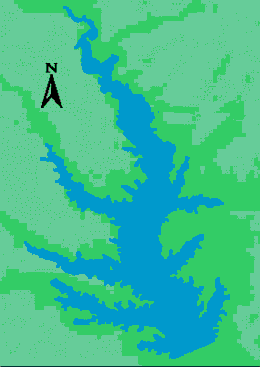Lake Conroe
Quick Links: Fishing Regulations | Angling Opportunities | Cover & Structure | Tips & Tactics
Lake Characteristics
Location: West Fork of San Jacinto River
in Montgomery and Walker Counties
Surface area: 20,118 acres
Impounded: 1973
Water Conditions
Current
Lake Level
Conservation Pool Elevation: 201 ft. msl
Fluctuation: 1-3 feet
Normal Clarity: Slight to moderate
algal staining
Reservoir Controlling Authority
San Jacinto River Authority
Conroe Project Office
PO Box 329
Conroe, Texas 77305
(936) 588-1111
Aquatic Vegetation
Low density
Predominant Fish Species
Lake Records
Current
Fishing Report
Stocking History
Lake Maps
National forest maps are available for a fee from the US Forest Service. Lake maps may be available through commercial sources.
Fishing Regulations
Most species are currently managed with statewide regulations. An exception is largemouth bass, which is subject to a 16-inch minimum length limit. A Triploid Grass Carp Permit is in effect on this lake. If a grass carp is caught, it must be immediately returned to the water unharmed.
Angling Opportunities
Largemouth bass are the most sought after species in Lake Conroe, though not the most abundant. While catch rates are marginal, the opportunity to catch a trophy bass is very good at Lake Conroe. In 1998, the biggest largemouth bass ever collected by TPWD in an electrofishing survey was taken from beneath a boat dock and weighed in at 14.1 pounds. The standing lake record caught in 1997 by Willis angler Bill Boyett weighed 14.91 pounds.
Channel catfish are by far the most abundant sportfish in the lake, offering most any angler a good opportunity for good catches. Bluegill on Lake Conroe grow to enormous sizes. We have interviewed anglers with 12-inch bluegills in their creels. Crappie are also very popular and offer good opportunity for anglers seeking table fare. White crappie have made a comeback in the lake with the efforts of the Lake Conroe Restocking Association's spring stockings of advance juvenile crappie. Crappie over two pounds are fairly common occurrences now. The introduction of hybrid striped bass in 1995 has added another dimension to the sport fishery, offering open-water opportunities for anglers who enjoy going after these hefty fighters.
| Species | Poor | Fair | Good | Excellent |
|---|---|---|---|---|
| Largemouth Bass | ||||
| Catfish | ||||
| Crappie | ||||
| White & Hybrid Striped Bass | ||||
| Bluegill |
Fishing Cover/Structure
Lake Conroe is dominated by open water in the lower two-thirds of the reservoir, with some standing timber still present along the river channel in the upper reaches. Most of the standing timber is slightly submerged when the lake is at conservation pool, making navigation hazardous in these areas. Bulkheads with boat docks dominate the shore in the lower reservoir; the upper reservoir (the portion lying within the Sam Houston National Forest) is primarily featureless shoreline. Substrates range from sandy to silty. A few aquatic plants dot shoreline areas, primarily in areas being planted by TPWD and the US Army Corps of Engineers as part of an ongoing Aquatic Habitat Enhancement Initiative. The lake has had past heavy infestations of hydrilla, but vegetation is not currently present in quantities that would be considered a nuisance. The only fish-attracting structures in the reservoir are rip rap along bridge approaches and the dam, as well as submersed Christmas tree reefs.
Tips & Tactics
Largemouth bass anglers can expect to take bass in shallow
water, particularly around marinas and boat docks, in the early spring and
mid- to late fall.
In other seasons, bass are taken around deeper cover. Anglers
are most successful with a variety of shad imitation lures or soft
plastic baits. Hybrid striped bass are growing in popularity
among Lake Conroe anglers and can be caught most any time of year. Most are
taken by anglers trolling in open water areas or vertically jigging spoons
or live
shad. They are occasionally found running up the river channel during the
early spring spawning run or foraging beneath schools of white bass in summer.
Channel catfish are caught year-round in good numbers.
Most successful anglers use smelly baits or cut shad. Rod-and-reel
anglers do just about as well as trotliners on this reservoir. Bluegills of
gigantic proportions can be had by the angler who wants to be patient
and target them. They can be caught along rip rap, fishing deep near
the toe of the slope (sometimes 8 feet or more). Baits must reach near
bottom quickly to avoid the small bait-stealers that inhabit the shallower
water. Live worms or crickets are the best producers.
Some good fly-rod action can also be had using sinking insect imitation
flies and sinking fly line.




 Texas Parks and Wildlife Department, 4200 Smith School Road, Austin, TX 78744
Texas Parks and Wildlife Department, 4200 Smith School Road, Austin, TX 78744